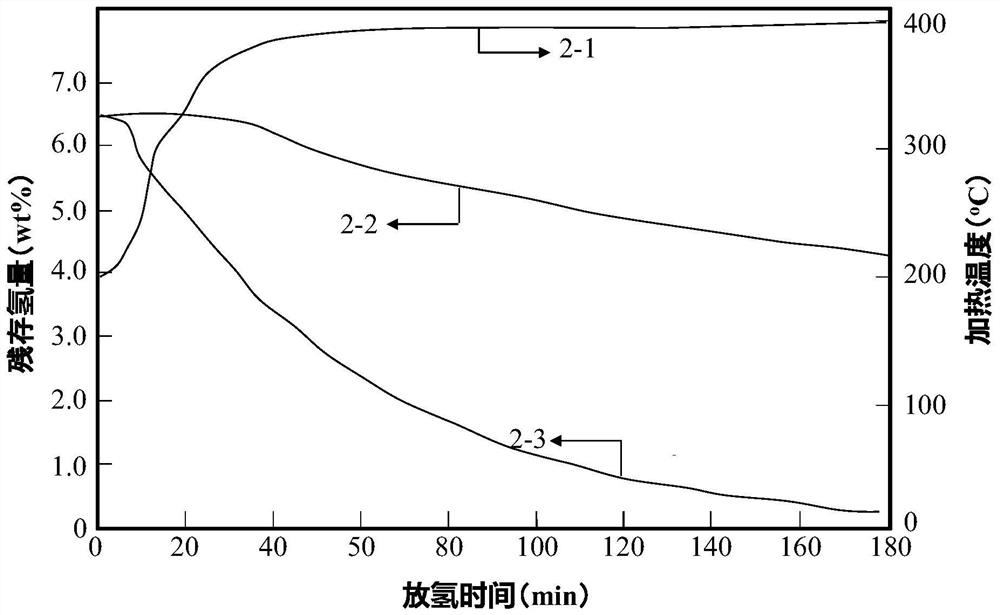Preparation method of polyaniline and Grignard reagent in-situ modification of rare earth magnesium-based hydrogen storage materials
A technology of stencil reagent and hydrogen storage material, applied in chemical instruments and methods, metal material coating process, hydrogen, etc., can solve problems such as hindering the practical process, hindering hydrogen permeability, decreasing hydrogen storage capacity, etc., and reducing magnesium The effect of reducing the activation energy of hydrogen absorption reaction, reducing the activation energy of hydrogen desorption reaction, and increasing the rate of hydrogen desorption
- Summary
- Abstract
- Description
- Claims
- Application Information
AI Technical Summary
Problems solved by technology
Method used
Image
Examples
Embodiment 1
[0033] Example 1: Preparation of covering flux for magnesium alloy smelting
[0034]The powders of anhydrous magnesium chloride, anhydrous potassium chloride, anhydrous barium chloride and anhydrous calcium fluoride in a mass ratio of 4:4:1:1 are ball milled and mixed for 1 hour to obtain a magnesium alloy smelting covering flux.
Embodiment 2
[0035] Example 2: La 2 Mg 17 Alloy Preparation
[0036] The powders of anhydrous magnesium chloride, anhydrous potassium chloride, anhydrous barium chloride and anhydrous calcium fluoride in a mass ratio of 4:4:1:1 are ball milled and mixed for 1.5 hours to obtain a magnesium alloy smelting covering flux.
[0037] Place small pieces of metal magnesium and metal lanthanum in a molar ratio of 8.5:1 in a crucible with the above-mentioned smelting covering flux (more than 2cm, the same below) spread on the bottom to form a material bed, and lay a layer of smelting on the material bed. Cover the flux, cover the crucible lid, and place it in a well-type furnace; heat up to 700°C at a rate of 10°C / min, and maintain it for 2 hours; cool to room temperature, turn the sample over, and place it again on the bottom with a melting cover The crucible of flux, and then lay a layer of melting covering flux on it, cover the crucible lid, and carry out turning over melting; after turning over...
Embodiment 3
[0038] Example 3: CeMg 12 Alloy Preparation
[0039] The powders of anhydrous magnesium chloride, anhydrous potassium chloride, anhydrous barium chloride and anhydrous calcium fluoride in a mass ratio of 4:4:1:1 are ball milled and mixed for 2 hours to obtain a magnesium alloy smelting covering flux.
[0040] Place small pieces of metal magnesium and metal cerium in the bottom of the crucible with the above-mentioned smelting covering flux at a molar ratio of 12:1 to form a material bed, and lay a layer of smelting covering flux on the material bed, and cover the crucible cover , placed in a well-type furnace; heated to 775°C at a rate of 10°C / min, and maintained for 1.5 hours; cooled to room temperature, turned the sample over, and placed it back in a crucible covered with melting flux on the bottom, and then Lay a layer of smelting covering flux on the top, cover the crucible lid, and carry out turning smelting; after 2 times turning and remelting, CeMg is obtained after co...
PUM
| Property | Measurement | Unit |
|---|---|---|
| melting point | aaaaa | aaaaa |
| boiling point | aaaaa | aaaaa |
Abstract
Description
Claims
Application Information
 Login to View More
Login to View More - R&D
- Intellectual Property
- Life Sciences
- Materials
- Tech Scout
- Unparalleled Data Quality
- Higher Quality Content
- 60% Fewer Hallucinations
Browse by: Latest US Patents, China's latest patents, Technical Efficacy Thesaurus, Application Domain, Technology Topic, Popular Technical Reports.
© 2025 PatSnap. All rights reserved.Legal|Privacy policy|Modern Slavery Act Transparency Statement|Sitemap|About US| Contact US: help@patsnap.com


